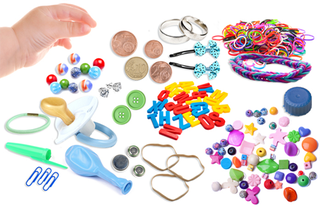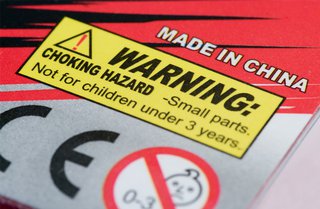Non-food choking risks include:
- button batteries and small batteries
- magnets
- small jewellery, parts of jewellery and teething jewellery
- coins
- keys
- pencils, crayons and pens and their lids
- balloons
- small toys and parts of toys
- marbles
- elastic and loom bands
- hair clips and accessories
- headbands and hairbands
- decorative and jewellery bands
- under-sized, worn or torn soothers or dummies
- wet wipes such as baby wipes and cosmetic wipes
Reduce the risk of a child choking
Do
-
always supervise your child
-
keep choking risks out of reach and sight of your child
-
place risky items in a high cupboard
-
use child safety cupboard locks
-
make sure your child plays with toys suitable for their age and development stage
Important
Never allow children to run with sharp objects, food or lollipops in their mouths

Batteries
Keep remote controls and other household items with batteries away from children.
Make sure all battery compartments on toys and other items are secure. Your child should not be able to open them.
Keep all spare or used batteries out of sight and reach of children.
Emergency action required: Go to hospital immediately if:
- you think your child has swallowed a button battery
A button battery can seriously burn their insides.

Jewellery
Never put any jewellery on a child under 3 years of age. This includes amber teething jewellery. The jewellery and its parts could be a choking and strangulation risk.
Toys
Make sure children play with toys that are right for their age and developmental stage. Only buy toys that have a CE safety mark on them from trusted shops.
Throw out broken and worn toys including soft toys.
Check second-hand toys very carefully. This includes toys bought online or from market stalls or discount shops.
Be aware that older children may share unsuitable toys with a younger child.

Balloons
Balloons are not toys. Only adults should blow them up. Always supervise your child when they are playing with balloons.
Children as old as 12 years have choked after the balloon they were blowing up lodged in their throat. Pieces of broken balloons or balloons not inflated are also a risk.
Hair accessories
Never place hairbands, headbands clips or hair ties on your baby or child until they are old enough to understand their danger. Headbands are made out of fabric. They can be a choking risk to a baby if they put them in their mouth.
Soothers
Throw away under-sized, worn or torn soothers or dummies. Make sure your baby's soother is the correct one for their age and developmental stage.
Wet wipes and cosmetic wipes
Keep wet wipes such as baby wipes and cosmetic wipes out sight and reach of children at all times.
Do not allow children to play with or hold wet wipes during nappy changes as they may try to suck or eat them.
Download our Child Safety checklist for parents
Child safety checklist for parents including child proofing (PDF, 5.32 MB, 2 pages)
Use the HSE's child proofing check list to help you child proof your home to protect your children. This list is also available from your public health nurse.
Child safety wallchart for parents including basic first aid (PDF, 3.22 MB, 4 pages)
Print this child safety wallchart and keep within easy access in your home. It includes tips on child safety, first aid information and emergency contact details.